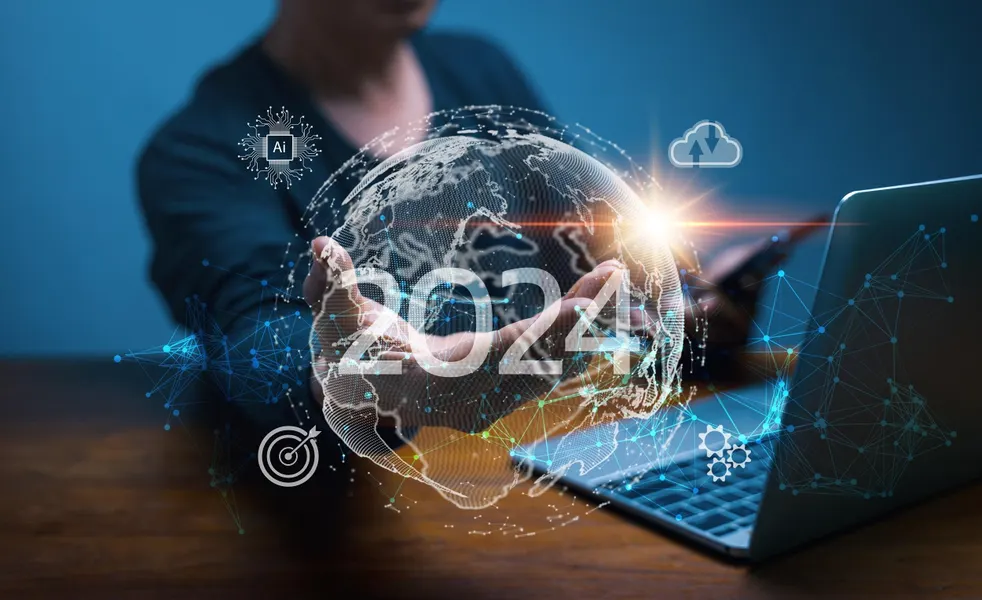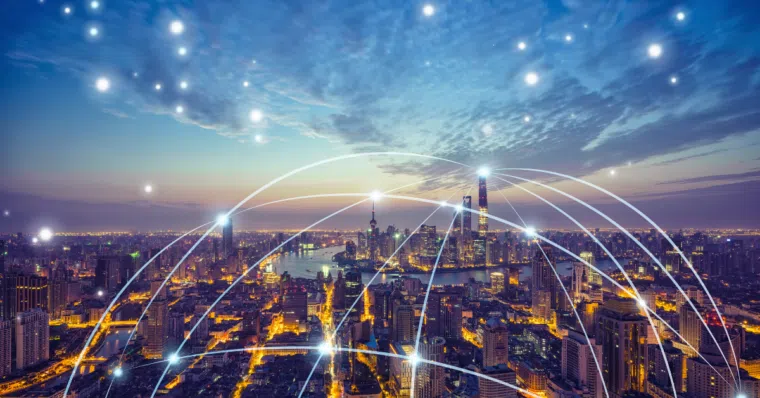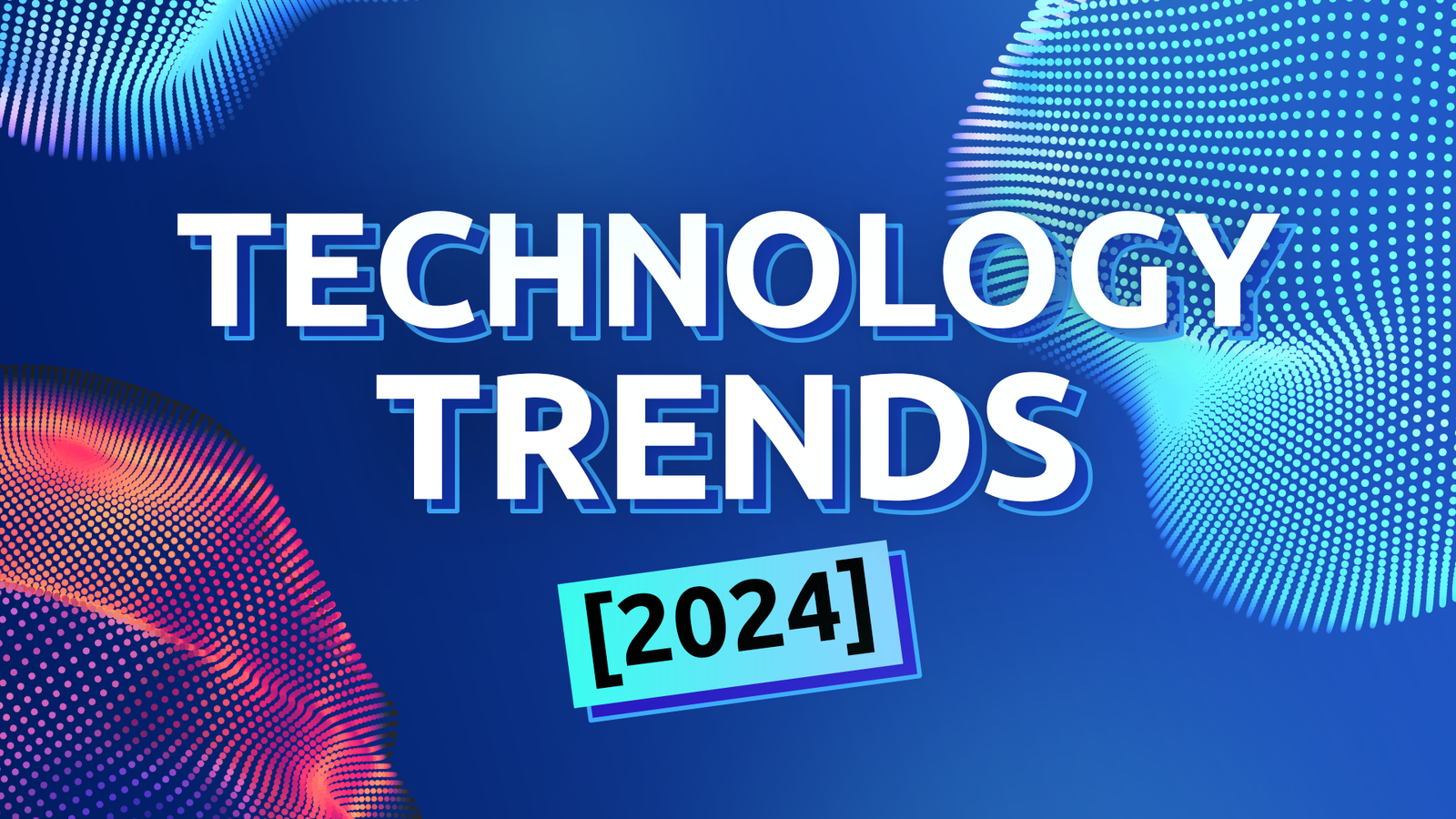In the grand symphony of human progress, the cadence of change reverberates through the vast expanse of the technological universe. It is not a mere constant but the very essence that propels us forward, igniting the flames of innovation and illuminating the path to a future yet unseen. As we embark on this exhilarating odyssey through the boundless realms of technology, let us not skim the surface but dive deep into the labyrinthine depths of 22 cutting-edge trends that stand as sentinels at the frontier of human ingenuity.
These trends are not mere echoes of transformation; they are the architects of the future, the alchemists who transmute dreams into realities, shaping our present and sculpting the contours of what lies ahead. Each trend is a testament to the relentless pursuit of progress, a beacon guiding us through the ever-shifting currents of change.
22 New Technology Trends
1. Artificial Intelligence (AI) and Machine Learning (ML):
In the hallowed halls of technological innovation, AI and ML stand as titans, heralding a new era of cognitive enlightenment. They are not just algorithms but the harbingers of a digital renaissance, ushering in an age where machines learn, adapt, and evolve, mirroring the intricate workings of the human mind.

2. 5G Technology:
5G technology marks a revolutionary leap in the digital landscape, far beyond being a mere evolution. Imagine traversing uncharted territories where the fifth-generation technology not only upgrades our connectivity but transforms the very essence of how we live, work, and communicate.
Envision a world where the boundaries of connectivity blur, and data streams seamlessly like a torrential river. This transformative power fuels the engines of innovation, sparking a paradigm shift in the way we interact with technology and each other.
3. Edge Computing:
In the crucible of technological innovation, edge computing emerges as a catalyst for change, blurring the lines between the physical and digital realms. It is not just a paradigm shift but a renaissance of computation, empowering devices to process data at the very precipice of creation, unleashing a torrent of real-time insights and redefining the boundaries of what is possible.
4. Quantum Computing:
In the labyrinthine depths of quantum computing, we embark on a journey into the unknown, where classical limitations crumble like sandcastles before the tide. It is not just a leap; it is a quantum leap, propelling us into a realm where computations defy convention, where problems once deemed insurmountable yield to the inexorable march of progress.
5. Blockchain and Cryptocurrencies:
Blockchain and cryptocurrencies are not just currencies; they are the cornerstone of a decentralized revolution, where trust is no longer vested in centralized authorities but enshrined in immutable ledgers. They are not just technologies; they are the architects of a future where transparency reigns supreme, where transactions are conducted with the click of a button, free from the shackles of intermediaries.
6. Internet of Things (IoT):
In the tapestry of technological innovation, the Internet of Things weaves a symphony of connectivity, where devices converse in a digital dialect, orchestrating a harmonious dance of data. It is not just a network; it is a tapestry, where every thread intertwines, creating a seamless fabric of interconnectedness that spans continents and transcends boundaries.
7. Augmented Reality (AR) and Virtual Reality (VR):
In the ethereal realms of AR and VR, we transcend the confines of the physical world, venturing into realms where imagination knows no bounds. They are not just technologies; they are portals, transporting us to realms where fantasy and reality converge, where experiences are not just observed but lived, in all their vivid splendor.
8. Cybersecurity Advances:
In the battlefield of cyberspace, cybersecurity emerges as the vanguard, defending against the relentless onslaught of digital adversaries. It is not just a shield; it is a bastion of defense, where algorithms stand as sentinels, guarding the gates of data and preserving the sanctity of digital domains.
9. Robotic Process Automation (RPA):
In the intricate tapestry of human progress, Robotic Process Automation (RPA) emerges as the master weaver, intricately threading the fabric of innovation by automating the mundane and liberating the human spirit from the shackles of repetitive tasks. Far beyond being a mere tool, RPA stands as the conductor of a grand symphony, orchestrating a seamless and harmonious blend of human ingenuity and machine precision.
Imagine RPA not merely as a technological innovation but as a transformative force reshaping the dynamics of human-machine collaboration. It is the liberator, releasing human potential from the drudgery of routine and mundane responsibilities. RPA becomes the catalyst for an environment where creativity flourishes, unburdened by the monotony of repetitive undertakings.
10. 3D Printing:
Within the crucible of technological innovation, 3D printing emerges as a transformative sculptor, molding the abstract contours of our imagination into tangible realities. Far more than a conventional technology, 3D printing assumes the role of an artistic medium, fostering a realm where dreams are not merely envisioned but materialize in a stunning display of intricate detail and splendor.
At its essence, 3D printing, or additive manufacturing, operates on the principle of layer-by-layer construction. This innovative process allows for the creation of three-dimensional objects by adding successive layers of material. The material choices range from plastics and metals to ceramics and even biological compounds, providing a versatile palette for the sculptor’s imagination.
11. Biotechnology and CRISPR:
In the realm of scientific discovery, biotechnology and CRISPR serve as architects, reshaping life’s building blocks. More than tools, they herald a new era where diseases are not just cured but eradicated, pushing boundaries further into the unknown. Biotechnology spans applications in medicine, agriculture, and the environment. CRISPR, a precision gene-editing tool, revolutionizes molecular biology, holding promise for treating genetic disorders and developing genetically modified organisms. These technologies, especially in medicine, offer hope for addressing genetic conditions at their source. In agriculture, biotech and CRISPR enhance crop resilience and yield. Ethical considerations loom large, requiring responsible use, regulatory measures, and public discourse to guide these advancements. In scientific progress, biotechnology and CRISPR emerge as pivotal forces, shaping a future where evolution’s architects navigate unknowns with profound ethical understanding.
12. Autonomous Vehicles:
Autonomous vehicles are pioneers in transportation, navigating with precision. They redefine mobility as a fundamental right, emphasizing safety and efficiency. These cars integrate AI, sensors, and computing for a transformative impact. Safety improves through reduced human error, using advanced technology. Efficiency benefits from smoother traffic patterns and optimized travel times. Autonomous vehicles extend beyond personal use, impacting logistics and freight. Challenges include ethical considerations, regulatory frameworks, and public acceptance. Striking a balance between innovation and societal concerns is crucial for success. In essence, autonomous vehicles reshape transportation, offering a future where mobility is accessible to all.
13. Voice Assistants and Natural Language Processing (NLP):
Voice assistants and NLP act as oracles, engaging in a new era of short conversations. They go beyond algorithms, becoming daily life companions, reshaping tech interactions. Smart homes exemplify this, where voice assistants seamlessly adjust settings. These systems aid inclusivity, democratizing tech access. Challenges like privacy concerns require careful consideration for sustained evolution. In essence, voice assistants and NLP redefine tech communication in a harmonious symphony.
14. Extended Reality (XR):
XR, including VR, AR, and MR, breaks physical constraints, offering immersive experiences. It’s not just tech; it’s a transformative gateway where reality blends with vivid imagination. XR engages senses, turning users into active participants in narratives. In education, it fosters deep learning through immersive experiences. In healthcare, XR aids surgical practice and therapeutic treatments. Entertainment industries leverage XR for cinematic, interactive, and enhanced performances. XR transforms collaboration, making virtual meetings immersive. Challenges include technical limitations, privacy concerns, and accessibility. Ethical considerations navigate XR’s impact on societal norms. In essence, XR is a gateway to boundless human experiences, redefining reality in vivid splendor.
15. Smart Cities:
Smart cities, with IoT, AI, and data analytics, blend technology seamlessly into daily life. Going beyond metropolises, they’re visionary architects of an era where sustainability and efficiency unite, pushing boundaries further. Leveraging sensors and devices, smart cities create interconnected ecosystems for dynamic urban interactions. Sustainability is pivotal, embracing eco-friendly practices, renewable energy, and efficient waste management. Smart grids optimize energy use, and intelligent waste systems minimize environmental impact. Efficiency, a cornerstone, optimizes transportation, public services, and resource allocation. Intelligent traffic and responsive public transport enhance urban life. Citizens engage through digital platforms, actively contributing to urban policies. Challenges like privacy, data security, and social inequities require careful consideration. In essence, smart cities redefine urban life, harmonizing technology, sustainability, and efficiency.
16. Renewable Energy Technologies:
Climate change urgency has spurred innovations in renewable energy, with solar, wind, and sustainable tech becoming integral to a cleaner, greener energy landscape. Solar power, using photovoltaic tech, efficiently converts sunlight into electricity, making solar energy more widely accessible. Wind energy, harnessed by turbines, generates power without emitting greenhouse gases, with offshore wind projects showing significant potential. Complementary technologies like hydropower, geothermal, and biomass contribute to a diverse renewable energy portfolio. Economic factors, such as declining costs and governmental incentives, drive the adoption of renewable energy, reshaping energy markets. This shift isn’t just technological but represents a paradigm change in how societies produce and consume power. Nations set ambitious targets for carbon neutrality, accelerating momentum towards a sustainable energy future. In essence, the push for renewable energy isn’t just about mitigating climate change but also creating a resilient, economically viable, and sustainable energy landscape for the future.
17. Health Tech:
Health Tech, at the intersection of technology and healthcare, initiates a patient-centric revolution. Telemedicine, wearable health devices, and AI-assisted diagnostics redefine how we access and receive healthcare services. Telemedicine facilitates remote consultations, breaking geographical barriers for convenient medical advice. Wearable devices empower individuals to monitor their well-being actively, providing real-time data for informed decision-making. AI plays a vital role in diagnostics, analyzing data for more accurate and timely assessments. Health Tech extends beyond individual care to enhance population health management through big data analytics. Despite advancements, challenges like data security and equitable access require careful consideration. In essence, Health Tech transforms healthcare into a more accessible, proactive, and personalized experience for individuals and communities.
18. Neuromorphic Computing:
Neuromorphic computing, inspired by the human brain, aims to emulate its efficiency. This paradigm mimics the brain’s parallel processing, enabling more efficient handling of complex tasks. The key advantage lies in replicating cognitive processes, allowing machines to learn and adapt, particularly beneficial for AI applications. Neuromorphic systems excel in energy efficiency, optimizing computational resources for reduced power consumption. They hold promise for cognitive computing, emulating human-like functions in robotics, autonomous vehicles, and natural language processing. Challenges include designing hardware and software for accurate emulation. Despite hurdles, progress in neuromorphic computing accelerates, offering transformative advancements in AI and cognitive computing.
19. 5G and Wi-Fi 6 Integration:
The synergy between 5G and Wi-Fi 6 is creating a seamless and high-speed connectivity experience. This integration is vital for supporting the growing number of connected devices and ensuring robust and efficient communication networks.
20. Digital Twins:
Digital twins, virtual replicas of physical objects or systems, are revolutionizing industries from manufacturing to healthcare. They provide a dynamic and real-time representation, enabling simulations, analysis, and monitoring.
21. Zero Trust Security Models:
In an era of increasing cyber threats, the Zero Trust security model is gaining traction. This approach challenges the traditional notion of a secure perimeter, requiring continuous verification and validation of every device and user.
22. Human Augmentation:
The integration of technology into the human body is pushing the boundaries of what it means to be human. From exoskeletons enhancing physical capabilities to brain-computer interfaces enabling direct communication with machines, human augmentation is a frontier of both promise and ethical considerations.

Conclusion:
As we traverse the digital frontier, these 22 technology trends are not just signposts; they are the architects of our tomorrow. The synergy between innovation and human ingenuity is creating a future where the unimaginable becomes reality.
In embracing these technologies, it is imperative to foster a culture of responsible innovation. Ethical considerations, security protocols, and inclusivity should guide our journey into the future. The digital landscape is vast and ever-changing, and as we stand on the precipice of possibilities, let’s navigate this frontier with curiosity, wisdom, and a shared vision of a better, more connected world. Welcome to the future – where the only constant is change, and the possibilities are boundless.
FAQs:
Q1: What are the top technology trends for 2024?
A1: The top technology trends for 2024 include advancements in artificial intelligence, the widespread adoption of 5G technology, the rise of extended reality (XR), the growth of decentralized finance (DeFi), and innovations in quantum computing, among others.
Q2: How will artificial intelligence (AI) evolve in 2024? A2: In 2024,
AI is expected to see advancements in natural language processing, reinforcement learning, and explainable AI. The integration of AI into various industries, such as healthcare, finance, and manufacturing, is likely to become more prevalent.
Q3: What role will 5G play in the technology landscape in 2024?
A3: 5G is anticipated to revolutionize connectivity in 2024, enabling faster data speeds, low latency, and supporting the widespread adoption of the Internet of Things (IoT). It will impact industries such as autonomous vehicles, smart cities, and augmented reality.
Read more. https://easyexpressxyz.com/2024/01/28/artificial-intelligence-history-uses-types-and-project-ideas/

